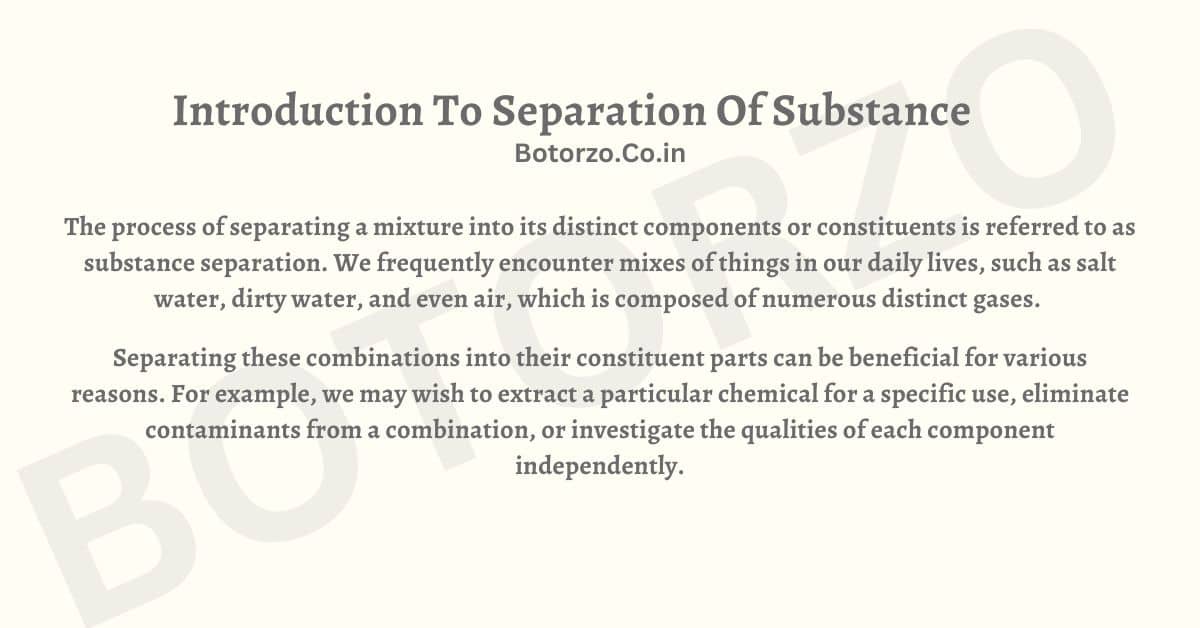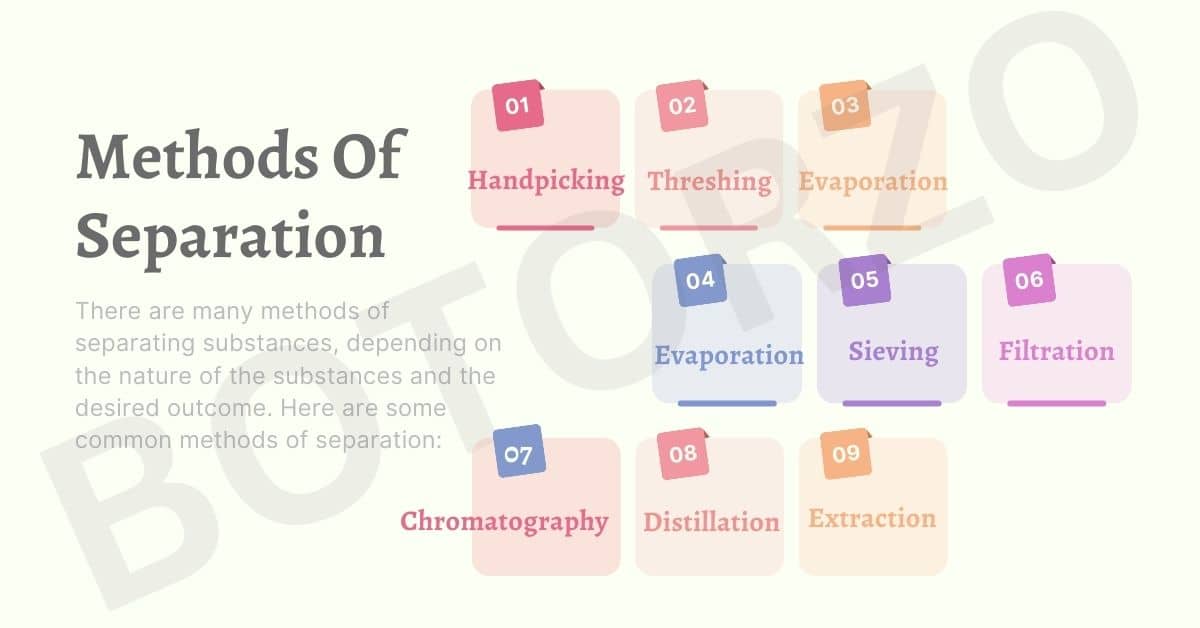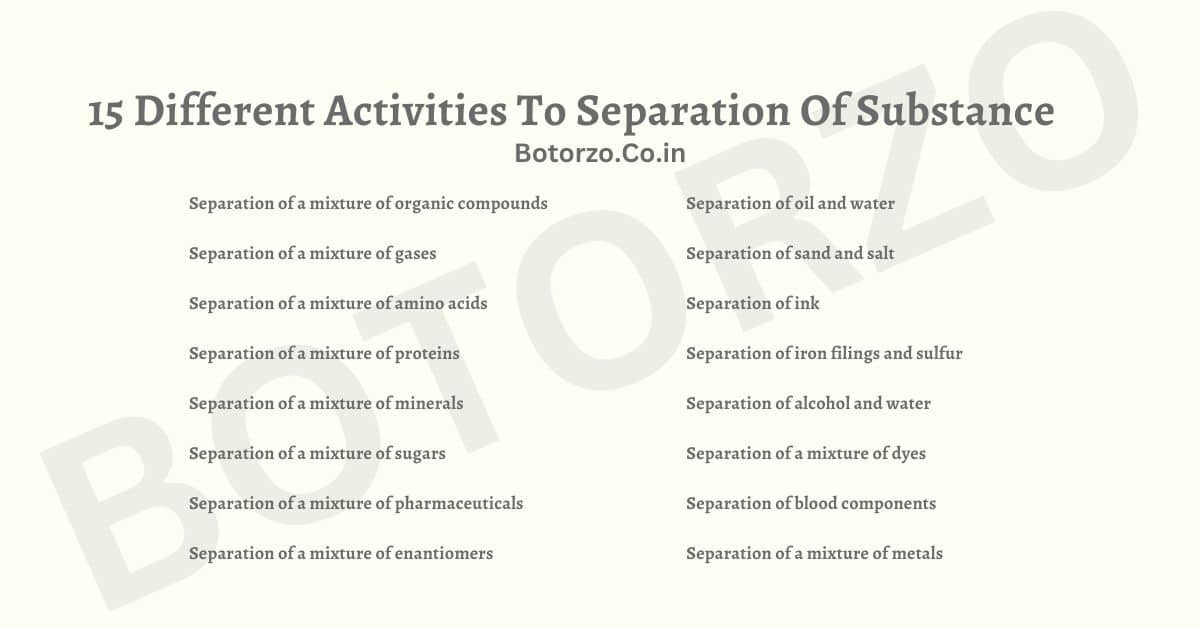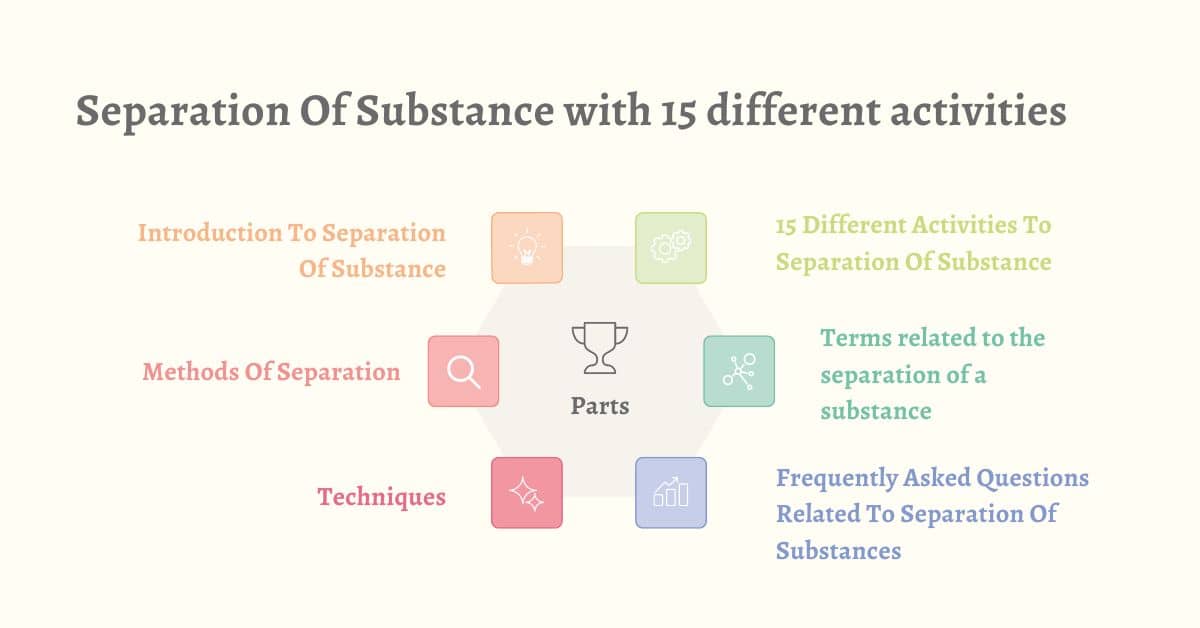Introduction To Separation Of Substance

The process of separating a mixture into its distinct components or constituents is referred to as substance separation. We frequently encounter mixes of things in our daily lives, such as salt water, dirty water, and even air, which is composed of numerous distinct gases.
Separating these combinations into their constituent parts can be beneficial for various reasons. For example, we may wish to extract a particular chemical for a specific use, eliminate contaminants from a combination, or investigate the qualities of each component independently.
There are several ways for separating compounds, and the method used is determined by the nature of the combination and the components involved. Filtration, evaporation, distillation, chromatography, and centrifugation are popular separation procedures. The physical and chemical properties of the substances involved, such as solubility, boiling point, density, and magnetic properties, are used to develop these procedures.
Many industries, including chemistry, biology, and industry, require the capacity to separate compounds. It enables us, among other things, to harvest rich resources, cleanse water and air, and manufacture medications. Understanding the concepts of material separation is thus a fundamental element of scientific education, and students are taught this topic early in their learning.
Read More topics related to class 6th Science
Methods Of Separation

There are many methods of separating substances, depending on the nature of the substances and the desired outcome. Here are some common methods of separation:
Handpicking
Handpicking is a basic way of separating material that involves picking individual particles of a mixture out by hand. This approach is frequently employed for big particles or chemicals that may be recognised by size, shape, or colour.
Handpicking can be used to remove pebbles from a mound of gravel, separate various varieties of nuts or sweets, or remove insects from a crop. Handpicking, on the other hand, is not appropriate for combinations with minute particles, which require a more exact separation process.
Read HandPicking method in More Details
Threshing
Threshing is a process of separating grains from the chaff, which is the plant’s inedible parts such as stems, leaves, and husks. In agriculture, this method is often used to harvest crops such as wheat, rice, and barley.
The gathered plants can be threshed by pounding them with a stick, using a threshing machine, or running them through a combine harvester. Threshing separates the grains from the chaff, allowing the grains to be collected and processed further.
Evaporation
Evaporation is the process of separating a solid dissolved in a liquid mixture. The liquid is heated in this manner, allowing it to evaporate and leaving behind a solid residue. The evaporated liquid can be separated and condensed.
This process is frequently used to extract salt from saltwater, in which the water is heated, forcing it to evaporate and leave the salt behind. In the laboratory, the evaporation method is also used to separate a solvent from a solution, where heat is added to the solution until the solvent evaporates and leaves behind the solute.
Sieving
Sieving is a process of separating different sizes of solid particles by passing them through a sieve, which is a device with a mesh or a perforated surface. When a mixture comprises particles of varying sizes and the appropriate particle size must be separated, this procedure is utilised.
Sieving, for example, is used in the construction industry to separate different sizes of sand and gravel, in the food business to separate different sizes of grains, and in labs to isolate particles of specified sizes for tests. Sieving is a frequent method of separation since it is efficient and very straightforward.
Filtration
Filtration: This is a method used to separate solid particles from liquids or gases by passing the mixture through a filter medium. The filter medium can be a paper filter, a mesh, or a membrane with small pores that trap the solid particles while allowing the liquid or gas to pass through.
Chromatography
Chromatography: This is a technique used to separate and analyze the components of a mixture based on their interactions with a stationary phase and a mobile phase. There are several types of chromatography, including paper chromatography, thin-layer chromatography, gas chromatography, and high-performance liquid chromatography (HPLC).
Distillation
Distillation: This is a method used to separate a mixture of liquids based on their boiling points. The mixture is heated until the liquid with the lowest boiling point evaporates and is then collected and condensed back into a liquid. This process is repeated for each liquid in the mixture with a higher boiling point until all the liquids have been separated.
Extraction
Extraction: This is a method used to separate a specific component from a mixture using a solvent or other chemical that selectively dissolves the component of interest. The mixture is usually placed in a separatory funnel and the solvent is added. The mixture is then shaken to allow the solvent to dissolve the component of interest, which can then be separated from the rest of the mixture.
Crystallization
Crystallization: This is a method used to purify a solid by causing it to crystallize out of a solution. The solution is heated to dissolve the solid and then allowed to cool slowly, causing the solid to crystallize out of the solution.
Sedimentation
Sedimentation: This is a method used to separate particles based on their weight or density by allowing the mixture to settle under gravity. The denser particles will settle to the bottom of the container while the less dense particles will float on top.
Centrifugation
Centrifugation: This is a method used to separate particles based on their weight or density by spinning the mixture at high speeds. The centrifugal force causes the denser particles to move towards the bottom of the container while the less dense particles move towards the top.
Electrophoresis
Electrophoresis: This is a technique used to separate charged particles, such as proteins or nucleic acids, based on their size and charge. The particles are placed in a gel matrix and an electric current is applied, causing the particles to move towards the opposite charge. The smaller particles move faster and farther than the larger particles, resulting in separation.
Adsorption
Adsorption: This is a method used to separate substances based on their ability to bind to a specific surface. The mixture is passed over a surface that has been treated with a substance that can selectively bind to the component of interest. The bound component can then be separated from the rest of the mixture.
Fractionation
Fractionation: A method of dividing a mixture into fractions based on variations in physical or chemical qualities
15 Different Activities To Separation Of Substance

Here are some activities related to the separation of substances with solutions (how to perform it) that you can try:
- Separation of oil and water
- Separation of sand and salt
- Separation of ink
- Separation of iron filings and sulfur
- Separation of alcohol and water
- Separation of a mixture of dyes
- Separation of blood components
- Separation of a mixture of metals
- Separation of a mixture of organic compounds
- Separation of a mixture of gases
- Separation of a mixture of amino acids
- Separation of a mixture of proteins
- Separation of a mixture of minerals
- Separation of a mixture of sugars
- Separation of a mixture of pharmaceuticals
- Separation of a mixture of enantiomers
Terms Related To The Separation Of A Substance
- Chromatography
- Filtration
- Distillation
- Extraction
- Crystallization
- Fractionation
- Sedimentation
- Centrifugation
- Ion exchange
- Adsorption
Frequently Asked Questions Related To Separation Of Substances
-
What is the separation of substances?
It’s the process of separating a mixture into its component parts.
-
What are the common techniques for the separation of substances?
They include filtration, chromatography, distillation, extraction, crystallization, sedimentation, centrifugation, ion exchange, adsorption, electrophoresis, and more.
-
What are the factors affecting the separation of substances?
They depend on the specific technique used, such as the properties of the substances being separated and the properties of the solvent or mobile phase.
-
What is chromatography?
It’s a technique used to separate and analyze the components of a mixture based on their interactions with a stationary phase and a mobile phase.
-
What is chromatography?
It’s a technique used to separate and analyze the components of a mixture based on their interactions with a stationary phase and a mobile phase.
-
What is distillation?
It’s a technique used to separate a mixture of liquids based on their boiling points.
-
What is filtration?
It’s a technique used to separate solids from liquids or gases by passing the mixture through a porous material or filter medium
-
What is an extraction?
It’s a technique used to separate a specific component from a mixture using a solvent or other chemical that selectively dissolves the component of interest.
-
What is crystallization?
It’s a technique used to purify a solid by causing it to crystallize out of a solution.
-
What is sedimentation?
It’s a technique used to separate particles based on their weight or density by allowing the mixture to settle under gravity.
-
What is centrifugation?
It’s a technique used to separate particles based on their weight or density by spinning the mixture at high speeds.
Our Another Domains Vidyapedia.in And Uietmdu.in


1 thought on “Methods of Separation Of Substance with 15 different activities”
Comments are closed.